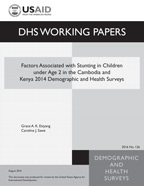
Abstract:
Background: This study examined the
relationships between child, maternal,
household, and gender inequality
characteristics and child stunting in Kenya
and Cambodia. Globally, an estimated 171
million children are stunted, including 167
million in low- and middle-income countries,
with especially high prevalence levels in
Africa and Asia. Child stunting reflects
chronic undernutrition, which often begins
before birth and is almost irreversible after
the second year of life.
Methods: The study analyzed data from the
2014 Demographic and Health Surveys (DHS
surveys) in Kenya and Cambodia for children
under age 2. Bivariate and logistic
regression analyses were performed to find
associations between the variables and child
stunting.
Results: The prevalence of stunting among
children under age 2 in Kenya was 22%, and in
Cambodia, 25%. Child’s age, perceived birth
size, family wealth status, and region of
residence were significantly associated with
stunting. In both countries children from the
richest households had 0.4 times lower odds
of being stunted compared with those from the
poorest households. In Kenya alone, female
children had 0.6 times lower odds of being
stunted compared with male children. In
Cambodia alone, children from rural areas had
0.6 times lower odds of being stunted
compared with those from urban areas, while
children whose mothers were underweight had
1.7 times higher odds of being stunted than
children whose mothers were not underweight.
In both countries, there was general lack of
a strong and significant relationship between
gender inequality and child stunting.
Conclusions: Children’s characteristics were
more important in predicting stunting than
factors related to mothers, households, or
gender. More extensive analysis of the DHS
data should be done to include other aspects
of gender inequality, such as decisions on
choice and preparation of food and purchase
of household goods.
 Factors Associated with Stunting in Children under Age 2 in the Cambodia and Kenya 2014 Demographic and Health Surveys (PDF, 529K)
Factors Associated with Stunting in Children under Age 2 in the Cambodia and Kenya 2014 Demographic and Health Surveys (PDF, 529K)
